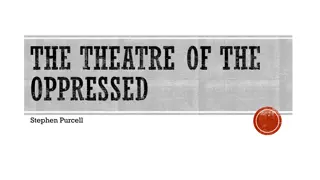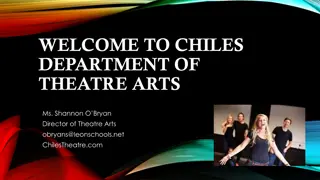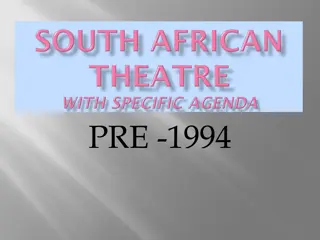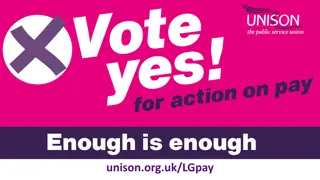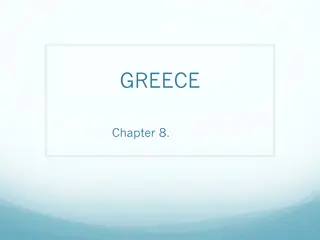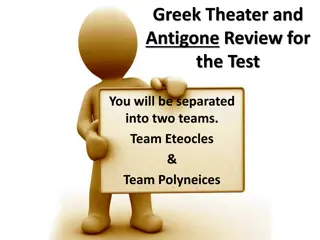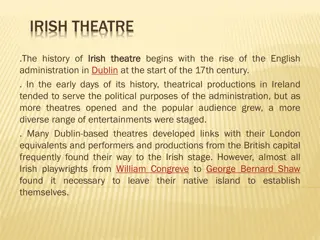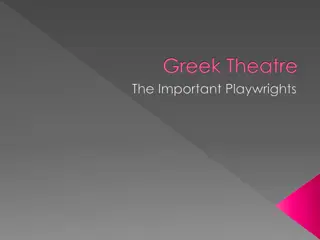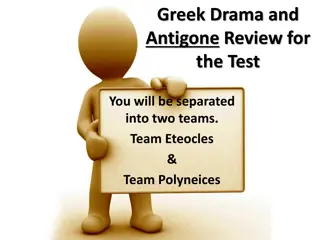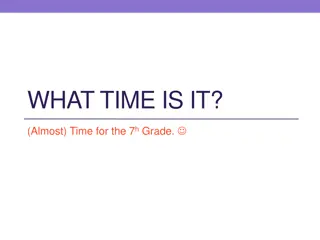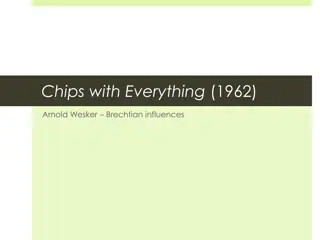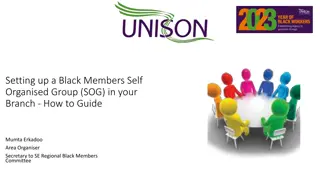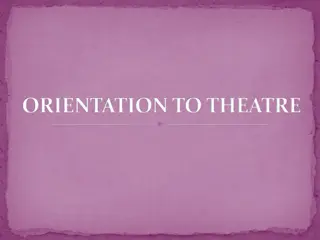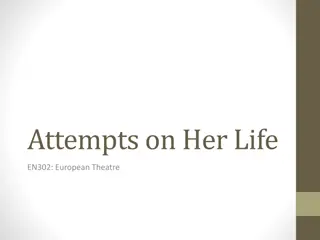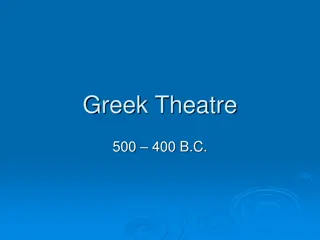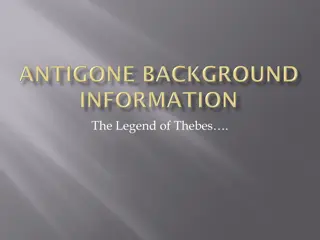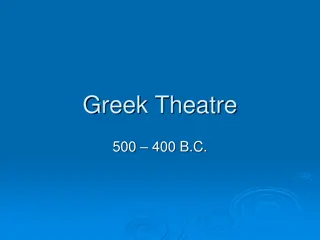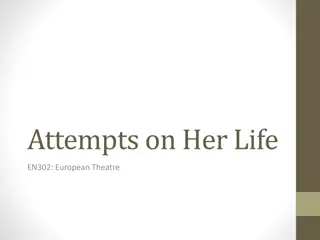Exploring Greek Theatre: Unison and Chorus Activity
Dive into the world of Greek Theatre with a focus on how the chorus is used, engaging in activities to understand unison and synchronization. Discover fascinating facts about Greek Theatre and its unique characteristics.
Download Presentation

Please find below an Image/Link to download the presentation.
The content on the website is provided AS IS for your information and personal use only. It may not be sold, licensed, or shared on other websites without obtaining consent from the author. Download presentation by click this link. If you encounter any issues during the download, it is possible that the publisher has removed the file from their server.
E N D
Presentation Transcript
GREEK THEATRE Year 8 Lesson One
Learning Outcomes By the end of the lesson I will have learnt: All: Certain aspects of Greek Theatre and how a chorus is used within Greek Theatre. Most: To experiment in groups around the idea of chorus, focusing on gestures, facial expressions and levels. Some: Specific facts about Greek Theatre and chorus and included them within performance and to comment effectively on peers performances.
Unison? In groups of 5 you are to mind-map your ideas on unison. You have 2 minutes.
Discussion What do I mean by Unison? Has anyone heard of the word before? If so, what examples are there? OCCURING AT THE SAME TIME AS ONE ANOTHER SYNCRONISATION Main focus of the lessons is to work together, as a chorus in Unison.
Activities Pass the Clap (whole class unison) Concentration, accuracy focus on energy, focus and eye contact. Mirror exercise (whole class unison) discreet while retaining accuracy, but must not discuss tactics! The technique just we just used was an important technique for the Greek Chorus in Greek Theatre. Duplicity (Paired unison) In pairs, facing each, you are to copy each other s movements and facial expressions, just like a reflection in a mirror. Accuracy, slowness and concentration are key. -Just mime no dialogue. Take it in turns to lead. What are the difficulties with moving in unison?
Greek Theatre Facts Performances took place in amphitheatres and these were very big. 1. 2. Performances were performed in the open air. 3. Semi-circular shape with rows of tiered stone seating around it. The shape of the theatres gave everyone in the audience excellent viewing and also meant they could hear the actors well too. 4. Instead of one actor telling a story a group of actors known as a chorus worked together. 5. Chorus worked in movement and voice so that stories could be heard and movements seen. 6. A chorus consisted between 5 and 50 actors. 7. All the actors were men. 8. They wore large masks that exaggerated facial features and emotions. The mouth hole was large to help amplify the voices. 9. Greek plays were either comedies or tragedies. Tragedies were often about the past, whereas comedies tended to be about current and everyday life.
Chorus Activity One The purpose of the Greek Chorus while moving in unison was to show the emotion of a play s story with their gestures and facial expressions. In groups 5 you are to find your own way of representing the following sequence of emotions using facial expressions, movements and gestures. use unison and no sound. pace, a leader, performance shapes in a line, semi-circle, triangle? Easy: HAPPY > SAD > ANGRY Medium: EXCITED > TIRED > BORED Hard: PROUD > NERVOUS > JEALOUS
Plenary What is one purpose of the Greek Theatre you have learnt today? What does Unison mean? What do you think the most important things to remember are in creating good unison? What facts can you remember about Greek Theatre?
GREEK THEATRE Year 8 Lesson Two
PASS THE RHYTHM
Greek Theatre??? What do you remember about Greek Theatre from last lesson? You have 1 minute to discuss with your partner. What do we remember about Chorus & Unison?
Learning Outcomes By the end of the lesson I will have learnt: All: Certain facts about a Greek Chorus and will have worked in a group as a Chorus. Most: To really experiment in groups as a chorus, focusing on over exaggerated gestures, facial expressions and levels. Some: To include specific facts about a Greek Chorus within performance. Thinking about certain dramatic techniques and to comment effectively on peers performances.
Chorus Facts 1. The chorus was one of the most important components of the play. 2. They narrated and reflected on the action. 3. Without them, the audience would have no background information, and the play would be more confusing. 4. Originally the chorus had twelve members. 5. They moved and spoken as one 6. They sang, or sometimes said, basic information. 7. They were the narrators of the play.
Chorus Activity Groups of 5 1) The hero had to prove that he was strong. 2) He was set a terrible task. 3) He fought the terrible monster. 4) The fight was hard and bloody. 5) The hero won. You must : Add an action with the line you have. choosing actions, gestures, movements and facial expressions to reflect the meaning. Join all 5 lines together. As a whole group you must: move in unison speak in unison, have eye focus direct address to the audience.
1) The hero had to prove that he was strong. 2) He was set a terrible task. 3) He fought the terrible monster. 4) The fight was hard and bloody. 5) The hero won.
Chorus Activity Groups of 5 you are to choreograph a short story (max 2 minutes) from one of the following titles: Unison on the dance floor Unison in the cinema Unison on the football pitch MUST display unison throughout NO SOUND TO BE USED. EXTENSION However, you could add more than one layer of unison. E.g.: the front row of the cinema can eat popcorn (in sync!), whilst the back row laughs at the film.
Plenary Describe two purposes of the Greek Chorus Thinking back to last lesson, can you relate any facts you learnt about Greek Theatre to suggest why the Ancient Greek s found a chorus so helpful? Are there any elements of the Greek Chorus that still exist today?
GREEK THEATRE Year 8 Lesson Three
Warm Up Activity In groups You must create a freeze frame based on the emotion that give you. You need to create a scenario in your groups based on the emotion. YOU ONLY HAVE ONE MINUTE!!!
In pairs discuss: 1) What is exaggerated acting? 2) Why must actors adopt this style when performing a piece of Greek Theatre?
Learning Outcomes By the end of the lesson I will have learnt: All: Why exaggerated acting style was necessary within Greek Theatre. Most: To really experiment in a group performance, focusing on over exaggerated gestures, facial expressions and levels. Some: To think about other dramatic techniques to use within performance and to comment effectively on peers performances.
Starter 1) Stand in a space on your own 2) When you hear a title or action you must individually create a frozen image based on that title. 3) If you do not freeze once I have shouted FREEZE then you are out! 4) Get Ready! What makes an effective frozen image?
It wasnt just the chorus who used exaggeration in Greek Theatre. Actors used precise gestures to represent clear emotions.
Exaggeration Experimentation In groups of 4-5 You must devise a short original scene based on one of these titles: Complaint at the chocolate factory Argument at breakfast Crisis in the X-Factor studio Robbery at a Post Office You Must: Use over the top acting style (exaggeration) Actors must only speak one person at a time. Must be accompanied by a posture and facial expression
Perform & Evaluate 1. Was there a particular movement or posture that worked particularly well? 2. Where there any emotions / key moments in the story that could have benefited from a movement or gesture that the group didn t use? 3. How realistic was the piece?
Plenary Why was exaggerated theatre so important? What skills can you take away from today s lesson for all drama lessons in the future?
GREEK THEATRE Year 8 Lesson Four
TRAFFIC LIGHTS RED = STOP! AMBER = JUMP UP & TOUCH FLOOR! GREEN = GO!
Learning Outcomes By the end of the lesson I will have learnt: All: Most: Some:


